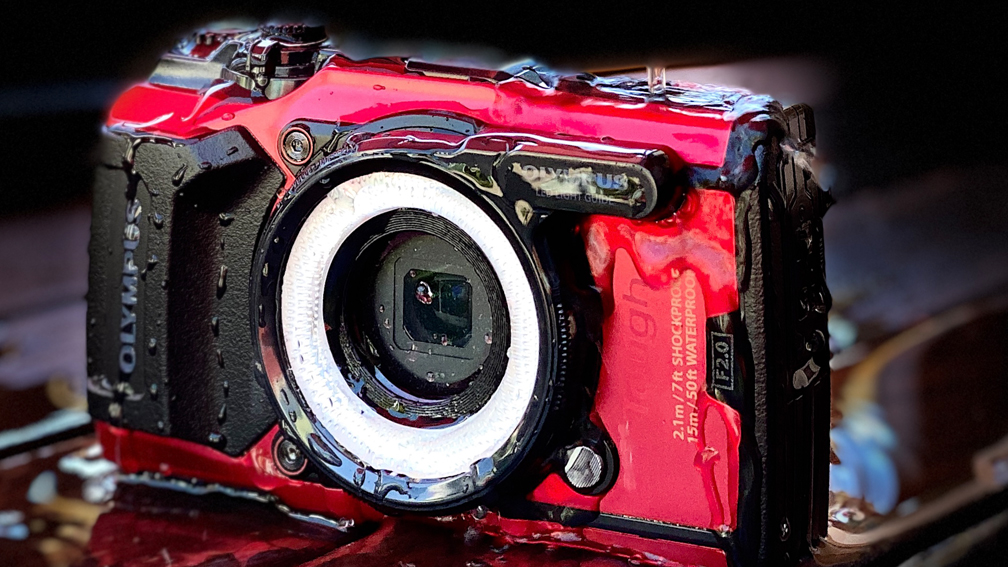A Unique Compact Camera
Reviewed by Steve Baczewski
The Olympus Tough TG-6 is a 12-megapixel, fit-in-your-pocket-sized compact camera, with a 1/2.3″ BSI-CMOS sensor that uses the same TruePic VIII processor as some of Olympus’s top-of-the-line professional cameras. It captures both RAW and JPEGs with an ISO range of 100–12,800 and can capture at up to 20 fps (RAW and JPEG). Its 4x optical zoom is the 35mm equivalent of 25–100mm and has a relatively fast variable aperture of f/2.0–f/4.9, making it versatile for capturing interiors, landscapes, and portraits; however, most other compact cameras can do that too.
What distinguishes the Olympus Tough series are the features and quality it brings to macro and underwater photography. Its mobility and quick access to features, especially related to macro photography, give it a convenience and spontaneity just not available on full-frame or APS-C sized cameras. Full disclosure: I didn’t take it underwater, except to use it in the rain and leave it covered with water overnight, and it started up without any hesitation.
All its compartments have double locks and, of course, are well sealed. It earns its “Tough” name from all the abuse it can withstand. It’s dustproof and waterproof down to 50′ (and even more with the optional PT-059 Underwater Case). It can withstand being dropped from 7′ (no, I didn’t try) and direct pressure of 220 lbf, and it works at 14° Fahrenheit. The lens resists fogging up by using an outer dual-pane glass design. It also has field sensors that collect and display data such as temperature, altitude, and GPS coordinates, and it has a compass. This last set of features puts a drain on the battery so there’s a convenient switch for turning them off.
It can capture 4K video at 30p; at 1080 it can also capture slow motion at 60p or 120p; and at 720 it can go to 240p. Besides the usual settings, the mode dial includes a fish icon for underwater and a microscope for macro shooting. Interestingly, there’s no shutter priority mode. I adjusted shutter speed indirectly by changing the aperture and ISO.
Performance is good. Single-shot autofocus is fast and accurate. It does occasionally hesitate and focus hunt in low light. In CAF (continuous autofocus) at 20 fps, I photographed a bicyclist going in various directions, and approximately 75% of the files were in focus.

The mode dial includes two custom settings, and when you press the OK button the screen displays a comprehensive menu of frequently used features for quick access and to avoid time scrolling the menus. When you select a speciality mode such as underwater or macro, a set of specific options appear on the screen to help define what you’re doing. For instance, the Macro mode includes Focus Stacking, Focus Bracketing, and a Microscope mode. The Microscope mode lets you zoom in and focus beyond the Tough’s focus limit of a centimeter and capture subjects such as a flower’s stamen at greater than 1:1. The TG-6’s Focus Stacking and the Focus Bracketing feature essentially do the same thing; however, Focus Bracketing will let you take up to 30 frames and Focus Stacking only up to 10 frames. Both are processed in camera. The results are impressive.
If you already own the Tough TG-5, the TG-6 is a very modest upgrade. The LCD’s resolution has been increased to 1.04 million dots, an anti-glare filter has been placed in front of the sensor, there are now three white balance modes to accommodate the changing light at varying depths of water, and the Microscope Macro mode has been added to underwater video capture.
I have several problems with the Tough TG-6: The shutter button offers too much resistance, resulting in occasional camera movement; the grip is too shallow; and, since there’s no EVF, the fixed 3″ 1.04 million-dot LCD is the only means for composing a picture. Even when you boost its brightness, it just doesn’t hold up to direct outdoor sunlight. That said, I love what this camera can do. ■







Timely review on the Olympus TG-6. I had recently seen a TG`5 and was looking for a full review of the TG`6, and there it is! And your review answered questions I didn’t even know I had. Thanks!